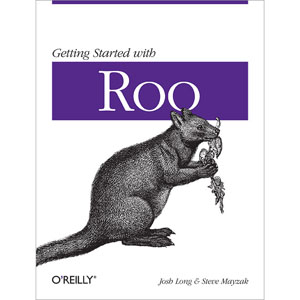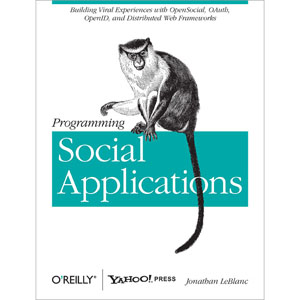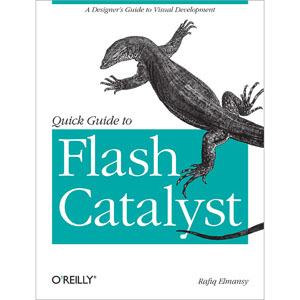| ActionScript Developer’s Guide to Robotlegs Posted: 05 Sep 2011 04:11 AM PDT 
Book Description Robotlegs is a standout among the ActionScript 3 development frameworks available today. With it, Flash, Flex, and AIR developers can create well-architected, testable, and flexible Rich Internet Applications—fast. This concise guide shows you how the light footprint and focused scope of this open source framework not only solves your immediate coding problems, it helps you gain insight into AS3 architecture on a much deeper level. The authors provide a walkthrough of specific features in two applications they’ve written in Robotlegs, complete with code for each application as a whole. You’ll learn how to achieve a balance of flexibility and consistency in your own projects. - Solve 80% of your coding problems with 20% of the API
- Gain code-base flexibility with automated Dependency Injection
- Learn the anatomy of a Robotlegs application
- Understand the relationships between models, services, control code, and views in the framework’s MVCS architecture
- See how the Robotlegs' approach facilitates Test Driven Development (TDD)
- Pick up practical methods for architecting Robotlegs solutions
- Get expert insights to power-up your existing Robotlegs code
About the Author
Joel Hooks is a Flash Platform developer with experience in Actionscript 3, Flex, and Python. Joel spent the first 13 years of his professional career as a 3d animator and graphic designer working on computer-based training applications from that perspective. His interest in programming goes as far back as “TELL TURTLE” and he has always been interested in the technological challenges related to developing software making work a little bit easier. With the introduction of Actionscript 3, Joel finally found a platform that allows him to architect useful tools while fully leveraging his experience as a visual artist. Joel is passionate about technology and enjoys exploring the landscape of frameworks, libraries, and tools that make his work constantly fun and challenging. Joel currently resides in Fort Worth and works as a Flex consultant for Universal Mind providing clients with oodles of clean code and a focus on test driven development solutions. Joel can be found blogging on various Flex development topics at http://joelhooks.com. Outside of developing software tools Joel owns a photography studio http://visualempathy.com with his wife who also collaborates on the raising and nurturing of his four home-educated children aged 13 to 4. Lindsey Fallow (aka Stray) has spent the past decade exploring science and technology as a writer, software developer, and television personality. Following an undergraduate degree in Manufacturing Engineering, she fronted a science show for 8-12 year-olds on Disney, and went on to become a reporter & Associate Producer for Tomorrow’s World (the BBC’s #1 prime-time UK science and technology show) from 1998-2002. She’s stood on the top of the Golden Gate bridge, fed sharks, filmed brain surgery, flown in military planes, and been bitten by a baby tiger, but is the most excited by far when her 16-year-old stepson ‘gets’ new math concepts. A Flash developer since Flash 4, Stray blogs on ActionScript, test driven development and the programmer’s brain at xxcoder.net. She is a core contributor to the Robotlegs framework, and actively pushing the ActionScript community to aspire to excellence through the try{harder} collaborative-learning format. Book Details - Paperback: 138 pages
- Publisher: O’Reilly Media (August 2011)
- Language: English
- ISBN-10: 1449308902
- ISBN-13: 978-1449308902
Note: There is a file embedded within this post, please visit this post to download the file. Related Posts |
| Getting Started with Roo Posted: 05 Sep 2011 04:07 AM PDT 
Book Description Spring Roo goes a step beyond the Spring Framework by bringing true Rapid Application Development to Java—just as Grails has done with Groovy. This concise introduction shows you how to build applications with Roo, using the framework’s shell as an intelligent and timesaving code-completion tool. It’s an ideal RAD tool because Roo does much of the tedious code maintenance. You’ll get started by building a simple customer relationship management application, complete with step-by-step instructions and code examples. Learn how to control any part of the application with Roo’s opt-in feature, while using this open source framework to automate the rest of the code. - Set up a Spring application and working Maven build to see Roo in action
- Address persistence with JPA and the Neo4j graph database—and learn how Roo supports NoSQL databases
- Use Roo's database reverse-engineering feature to generate a data model from an existing schema
- Build Roo applications with Spring MVC, Spring WebFlow, Google Web Toolkit, Vaadin, and other web frameworks
- Secure and test your application
About the Author
Josh Long is the Spring developer advocate, an editor on the Java queue for InfoQ.com, and the lead author on several books, including Apress' Spring Recipes, 2nd Edition. Josh has spoken at many different industry conferences internationally including TheServerSide Java Symposium, SpringOne, OSCON, JavaZone, Devoxx, Java2Days and many others. When he's not hacking on code for SpringSource, he can be found at the local Java User Group or at the local coffee shop. Josh likes solutions that push the boundaries of the technologies that enable them. His interests include scalability, BPM, grid processing, mobile computing and so-called "smart" systems. He blogs at blog.springsource.org or joshlong.com. Mr. Mayzak is part of the Cloud Applications Platform team at VMware. As part of this team he is focused on mapping our solutions to customers needs and ensuring that what we offer fits their requirements. He is constantly in the field working with customers on their Cloud initiatives. Book Details - Paperback: 58 pages
- Publisher: O’Reilly Media (August 2011)
- Language: English
- ISBN-10: 1449307906
- ISBN-13: 978-1449307905
Note: There is a file embedded within this post, please visit this post to download the file. Related Posts |
| Making Isometric Social Real-Time Games with HTML5, CSS3, and Javascript Posted: 05 Sep 2011 04:04 AM PDT 
Book Description Walk through the process of designing and implementing from scratch an isometric real time game such as some of the most succesful Facebook Games. Applying HTML5, CSS3, and JavaScript, this piece shows how to build games using isometric map making, sprite animations, networking, social network integration, high performance rendering and game design. Table of Contents
Chapter 1 Graphics Foundations: Canvas and Sprites - Working with the canvas Object
- Creating Smooth Animations
- Working with Sprites
- What's at that Pixel?
- Choosing a Rendering Method for Our Graphics
Chapter 2 Making It Isometric
Chapter 3 Interface Considerations - GUI Design and Interaction in Web Games
- Implementing the GUI
Chapter 4 HTML5 Sound and Processing Optimization - Adding Sound with the Audio Element
- Managing Computationally Expensive Work with the Web Workers API
- Local Storage and Session Storage
Chapter 5 Connecting the Game to People - Cheat Prevention and Server-Side Operations
- The Path to the Final Game
- Polishing the Game
- Adding a Social Networking Layer Using Facebook
About the Author
Andres Pagella is an accomplished software developer with more than 10 years of professional experience living in Capital Federal, Argentina. He has worked on the design and the implementation of several high traffic websites in Argentina. He currently works as the Chief Technical Officer of Minor Studios Argentina S.R.L. developing a social game design tool called Atmosphir. Book Details - Paperback: 154 pages
- Publisher: O’Reilly Media (August 2011)
- Language: English
- ISBN-10: 1449304753
- ISBN-13: 978-1449304751
Note: There is a file embedded within this post, please visit this post to download the file. Related Posts - Pro Android Web Apps: Develop for Android using HTML5, CSS3 & JavaScript (10-03-2011)
- jQuery Mobile (14-07-2011)
- HTML5 Canvas (07-05-2011)
- Beginning iPhone and iPad Web Apps: Scripting with HTML5, CSS3, and JavaScript (07-01-2011)
- The Web Designer's Guide to iOS Apps: Create iPhone, iPod touch, and iPad apps with Web Standards (HTML5, CSS3, and JavaScript) (09-03-2011)
- The Essential Guide to HTML5 (28-10-2010)
- The Definitive Guide to HTML5 Video (21-12-2010)
- Supercharged JavaScript Graphics: with HTML5 canvas, jQuery, and More (05-08-2011)
- Smashing CSS: Professional Techniques for Modern Layout (28-02-2011)
- Professional Web Design, Volume 2 (18-03-2011)
|
| Programming Social Applications Posted: 05 Sep 2011 03:59 AM PDT 
Book Description Social networking has made one thing clear: websites and applications need to provide users with experiences tailored to their preferences. This in-depth guide shows you how to build rich social frameworks, using open source technologies and specifications. You’ll learn how to create third-party applications for existing sites, build engaging social graphs, and develop products to host your own socialized experience. Programming Social Apps focuses on the OpenSocial platform, along with Apache Shindig, OAuth, OpenID, and other tools, demonstrating how they work together to help you solve practical issues. Each chapter uncovers a new layer in the construction of highly viral social applications and platforms. - Learn how to build applications on top of social containers, and leverage existing user data
- Map user relationships with a social graph, and extend social links between users
- Customize your application with user profile information and encourage growth through friendships
- Build a scalable social application container with OpenSocial and Shindig
- Dive into advanced OpenSocial topics such as templating and data pipelining methods
- Protect your container and its users against malicious code
About the Author
Jonathan LeBlanc is a technology evangelist and principal software engineer working with the Yahoo! Developer Network in Sunnyvale, California. Specializing in open source initiatives around the implementation of social engagement services, Jonathan works with and promotes emerging technologies to aid in the adoption and utilization of new social development techniques. As a software engineer, Jonathan works extensively with social interaction development on the web, engaging in new methods for targeting the social footprint of users to drive the ideal of an open web. Book Details - Paperback: 544 pages
- Publisher: O’Reilly Media (August 2011)
- Language: English
- ISBN-10: 1449394914
- ISBN-13: 978-1449394912
Note: There is a file embedded within this post, please visit this post to download the file. Related Posts |
| Quick Guide to Flash Catalyst Posted: 05 Sep 2011 03:55 AM PDT 
Book Description How do you transform user interface designs created in Photoshop or Illustrator into interactive web pages? It’s easier than you think. This guide shows you how to use Adobe Flash Catalyst to create interactive UIs and website wireframes for Rich Internet Applications—without writing a single line of code. Ideal for web designers, this book introduces Flash Catalyst basics with detailed step-by-step instructions and screenshots that illustrate every part of the process. You’ll learn hands-on how to turn your static design or artwork into working user interfaces that can be implemented in Flash Builder or Adobe AIR. - Get an overview of Flash Catalyst's interactive components
- Import files from Photoshop, Illustrator, or Fireworks
- Convert your artwork into interactive components and apply specific actions
- Create animated transitions between the web pages in your project
- Test interactive components and transitions while you work
- Get optimization tips to help you create fast-loading applications
- Export projects to the SWF format for web use, or to Adobe AIR for desktop applications
About the Author
Rafiq Elmansy has been a graphic designer for 10 years with a background in traditional art and sculpture. His experience in graphic design includes working on different design projects as well as creative directing. He runs his own design company, Pixel Consultations at www.pixelconsultations.com. He is also an Adobe Community Professional, Adobe Certified Expert in Flash and Photoshop, and the founder and manager of the Adobe user group in Egypt (AUGE), the first Adobe user group in the Middle East. Rafiq is also part of the Adobe Prerelease Program. Rafiq Elmansy is an author in the graphic and design field. His articles are published in Adobe design and developer center, Adobe Edge, communitymx.com, and his design blog www.graphicmania.net. He is the author of Photoshop 3D for Animators published by Focal press. Book Details - Paperback: 74 pages
- Publisher: O’Reilly Media (August 2011)
- Language: English
- ISBN-10: 1449306748
- ISBN-13: 978-1449306748
Note: There is a file embedded within this post, please visit this post to download the file. Related Posts |







Tidak ada komentar:
Posting Komentar